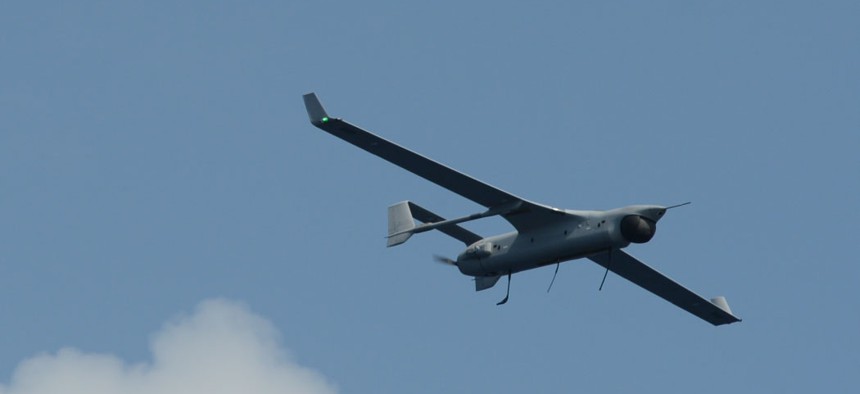
Marines successfully fly Blackjack UAS in controlled airspace
A Marines Corps unit recently conducted successful flights of the RQ-21A Blackjack in Class D controlled airspace allowing for simultaneous flights with manned aircraft.
In what’s being described as a positive step forward, the Marines recently conducted successful flights of the RQ-21A Blackjack in Class D airspace over Marine Corps Air Station Cherry Point, N.C. last week.
The Federal Aviation Administration defines Class D airspace as one of five controlled airspaces. It’s generally measured from surface to 2,500 feet above the elevation of surrounding airports with an operational control tower. Configurations for Class D airspace, the FAA further says, are individually tailored.
For the Marines’ purposes, Cherry Point’s Class D airspace was defined “by a circle around the air station with a 5-mile radius, from the ground up to 2,500 feet above the air station. This is airspace that is constantly under the control of Cherry Point air traffic control, and is frequently busy with military air traffic, as well as contracted commercial flights landing and departing the air station,” the service stated in a release.
The Blackjack flight is a breakthrough because it typically is only permitted to fly in restricted airspace. The Marine Unmanned Aerial Vehicle Squadron 2, known as VMU-2, now has expanded abilities to integrate Blackjack flight operations with manned aircraft over this particular air station.
“Unmanned aerial systems like the Blackjack are commonly flown from forward sites that sometimes restrict our integration with other air players and events,” 1st Lt. Orlando J. Benedict, an UAS officer with VMU-2, said. “Having the RQ-21A at MCAS Cherry Point fosters connections with the rest of the 2nd Marine Aircraft Wing and allows for procedures that integrate manned and unmanned aviation to be solidified for the future.”
The Blackjack, a maritime ISR unit used by the Navy and Marines, is capable of 16-hour flights – with a surging capability of 24 hours if needed – and a ceiling of over 19,000 feet. It’s used to support ground forces and can safeguard military bases, identifying activities in the area as well as detect explosive devices.
“The Blackjack’s main purpose is to support aerial reconnaissance missions,” said Sgt. James E. Burch. “With the new system, we will now be able to launch and land the UAV on a ship, where with other systems, more space would be required for recovery.” The successful Blackjack flight reduces unnecessary travel to other bases across the country to conduct UAS training.
“Marine UAS are flown and treated like any other aircraft, the only exception is that the pilot at the controls is not physically located in the plane, but they are very much still in control,” said 1st Lt. Jeremy Eshleman, a UAS officer and weapons and tactics instructor with VMU-2. “Our UAS flies a standard and predictable route under control of the tower while here at Cherry Point, and the pilot will perform any additional instructions as issued by the tower. In the rare event the pilot loses connection with the UAS and can no longer control it, it will only fly a predetermined route to a known location before landing at our site,” Eshleman added.
The Marines have refined UAS concept of operations allowing rapidly emerging technology integration. However, the service received poor marks on certain aspects of the Blackjack program from an annual report issued by the DOD office of the Director of Operational Test and Evaluation. The report concluded that the Blackjack was not operationally effective or and had exploitable cybersecurity vulnerabilities. Even more startling, the report found that communications relay payloads are constrained by a single frequency, limiting commanders’ tactical flexibility with operators incapable of changing frequencies once the aircraft is airborne.